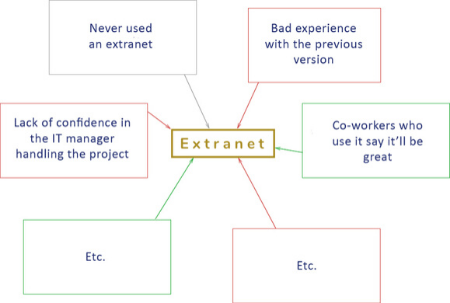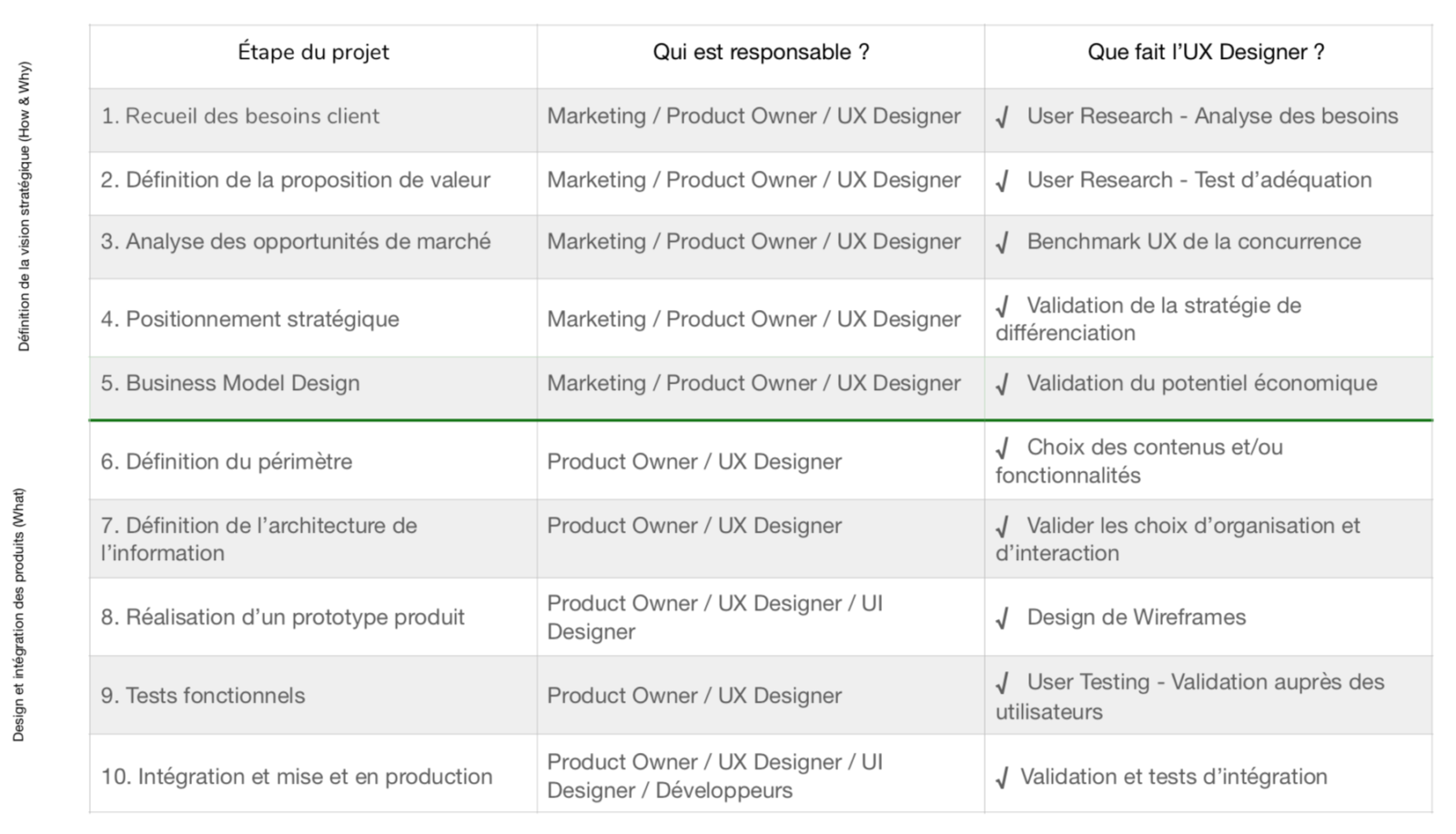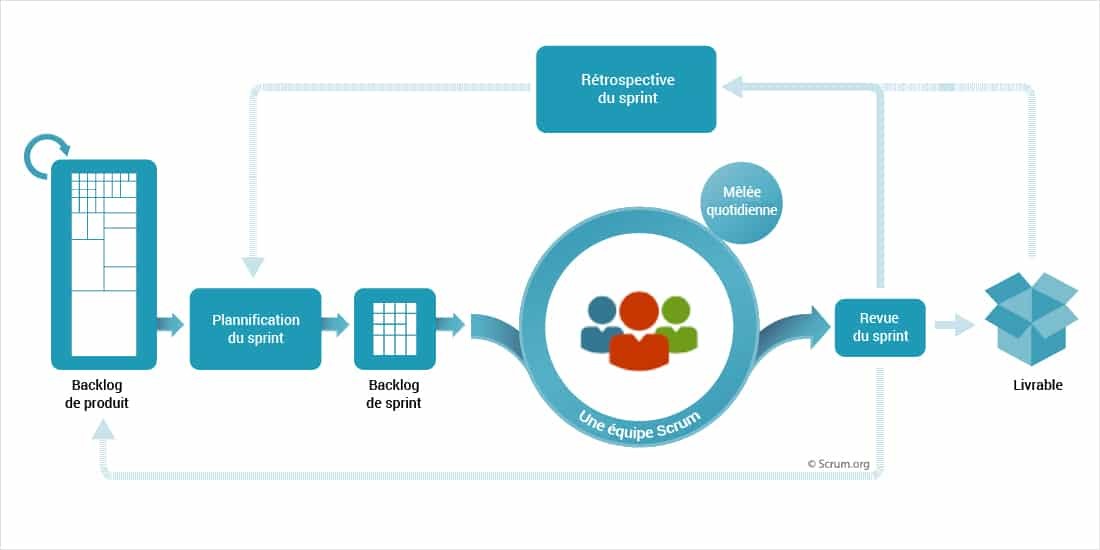UX Design
This is a difficult question because everyone has a different interpretation of what exactly constitutes an agile methodology and of the UX Designer’s role.
What is UX design?
Although this question might seem a bit basic, it’s worth exploring the topic to ensure we’re all on the same wavelength.
UX = user experience et Design = well… design!
UX design is a discipline that involves measuring and analysing a person’s behaviour when they interact with a value proposition, the aim being to ensure that the overall experience the user has is optimal.
The role of a UX designer is to precisely understand by whom, why, how and in which context the value proposition will be “consumed”, in order to guarantee the quality of the experience accompanying this value proposition.
We can all agree that a value proposition is the sum total of everything you present to your customer: it’s your showcase. It’s about your main product, as well as everything that accompanies it (services, distribution, etc.).

Imagine you’re developing an extranet for a company. This extranet is the product. Everything that will influence the perceived value from using this product falls under the “user experience”. Here are a few examples illustrated in the diagram opposite:
In this case, a UX designer seeks to understand:
- The reasons why a user will log on to the extranet.
- In which context(s) they will do so.
- What results they expect from using the extranet.
- What obstacles could prevent them from using it under optimal conditions.
It’s essential to understand that the DNA of any UX approach is the user.
Instead of saying: “Here’s the product we want to develop, shall we define how it can meet the needs of this customer segment? “. We say: “We’ve identified these needs in this customer segment, what we need to develop to meet them precisely? ”
With the aim of always being able to show that the value proposition and the needs expressed are perfectly aligned, a UX approach must incorporate the user into the key phases developing a product in order to reduce risk and uncertainty. When you put forward assumptions about this alignment, you take the time to conduct a few interviews with users to check how accurate they are.
That doesn’t mean you’re asking them to do the work instead of us, simply that you’re drawing on precise knowledge of their needs in order to bring them a suitable offering.
A good UX designer needs to take on the following responsibilities:
- They need to be the best at understanding and expressing users’ needs.
- They need to be able to convey the strategic vision of the product supported by the product owner.*
- They need to guarantee the overall vision of the value proposition that goes beyond the product.
- They need to guarantee that the solutions developed and the solutions the user expects are perfectly aligned.
At what point can UX design become involved in the development of an IS project?
This question depends on the key stages assigned to the development of an IS project. In the example below, imagine that we’re deciding to launch a new product starting with a blank page.
Development of a product. If we assume (quite rightly) that they’re responsible for making sure that all of the decisions made about the value proposition meet the user’s needs, they need to work in collaboration with all of the teams.
How does UX design need to be integrated into agile/scrum ceremonies?
Now that we’re aware of the role a UX designer can/must play in an IS project, we need to look at the question of role management and administration. How can these skills be relevantly integrated into agile ceremonies, and in particular scrum organisations?
A UX designer has two types of responsibilities: one is to a right of review on everything that’s being done to ensure strict compliance with user needs; the other is purely operational, to provide the right tools to the teams so they can be productive.
To try to answer this question, let’s look at the diagram below, which many of you have certainly already seen.
Before an initial product backlog is assembled by the product owner, the UX designer needs to have completed various tasks:
- Gather needs: To do so, they conduct a qualitative study to accurately identify the user needs. Specifically, this involves identifying all of the information required for designing and developing the value proposition as a whole. Instead of focusing on the demographic and marketing attributes, which aim to identify “who is” the customer, they instead focus on the reasons that will drive the customer to use the value proposition in a specific context. The documents to provide are a complete and detailed study report + a persona that will be used as a benchmark by all of the teams.
- The persona: Why should the persona, which is ultimately just a document, have such an important place in the process above? Quite simply because what counts isn’t necessarily the document itself but what you’ll do with it. The benefit of the persona is that it gives all of the teams an initial level of identical information about each customer segment. The UX designer’s role at this stage is therefore to communicate this persona and, more broadly, the result of their work on gathering needs.
- The release plan:Even though the release plan is the product owner’s responsibility, it’s essential for both these people to work together in order to achieve a result that makes sense. During the release strategy, the goal is to define and specify what will be developed in the coming months. To ensure that work is done properly, this plan needs to be able to target the most important requirements stated by users and it needs to be aligned with the company’s strategic vision. Note that there are no specific UX deliverables at this stage, that’s the product owner’s responsibility. The UX designer just has to draw in their knowledge to assist the PO.
Once the release work is complete, we therefore come to assembling the first product backlog, which logically should concern the first release.
- The product backlog: During their field studies, the UX designer didn’t stop at determining what the user’s specific needs were, they also and most importantly identified the best way of meeting these. Specifically, they need to help the PO convert each need into a solution. For example, if the stated need is to be able to contact after-cell support, the UX designer needs to know if it’s best to use telephone, chat, email, etc. Furthermore, if chat is the best solution, the UX designer needs to be in a position to know what the user likes or is concerned about when using this type of tool.
Next it’s time for sprint planning.
- Sprint planning:When it comes to the sprint planning stage, the UX designer needs to be able to help the PO and potentially the technical teams to define the detailed functional specifications and precise acceptance conditions. This document can be produced in several forms:
As far as other ceremonies are concerned, such as grooming, the stand-up meeting, the review and the retrospective, I feel that the UX designer always needs to be there.
As you’ll undoubtedly no, scrum isn’t a methodology per se that you follow the letter, it’s more of a state of mind and a production rationale. That means you can’t say at this stage “you should include a UX designer in such-and-such a way, at this time and not in any other way” –particularly because each UX designer is different and can bring more value to some subjects than others. However, it’s important to remember that whatever their preferred topics and preferences are, the UX designer’s main role is to guarantee that the product you’re developing perfectly meets the user needs. Having a user-centric approach means being humble enough to say “I’m not sure this is the best solution, let’s validate these assumptions with the customers first”.
Not being humble enough when you’re developing a product (digital or otherwise) means risking becoming the next« Juicero »…
Antoine Devaux


